Discover the Power of Advanced Spray Foam Insulation Solutions
Spray foam insulation represents one of the most sophisticated and reliable solutions available for enhancing building energy performance, indoor comfort, and environmental control. Unlike traditional materials such as fiberglass batts or loose-fill cellulose, spray foam forms a continuous, airtight barrier that seals every crack, crevice, and irregular space within the building envelope. Its superior ability to resist heat transfer, block moisture ingress, and eliminate air leaks results in substantial energy savings, healthier indoor environments, and even added structural integrity in specific applications.
This article offers comprehensive technical insights, in-depth comparisons, and practical evaluation tools. By the end, you will possess the critical knowledge needed to choose, apply, and maximize the benefits of advanced spray foam insulation solutions according to your unique building requirements.
Types of Advanced Spray Foam Insulation Solutions
Spray foam insulation is available in several types, each specifically engineered to perform optimally under different building conditions, climate zones, and design goals. Distinguishing among them is essential for maximizing long-term performance and investment value.
Open-Cell vs. Closed-Cell Spray Foam
| Feature | Open-Cell Spray Foam | Closed-Cell Spray Foam |
| Density | ~0.5 lbs/ft³ | ~2 lbs/ft³ |
| R-Value per inch | ~3.5 – 3.8 | ~6 – 7 |
| Permeability | High (allows vapor diffusion) | Low (acts as vapor barrier) |
| Cost | Lower | Higher |
| Structural Strength | Moderate | High |
| Sound Dampening | Excellent | Good |
| Best Applications | Interior walls, attics | Basements, roofs, exterior walls |

Open-cell foam, while softer and more permeable, offers outstanding sound absorption and cost efficiency, making it ideal for interior applications where vapor barriers are not critical. Conversely, closed-cell foam delivers exceptional R-value, moisture resistance, and structural strength, essential for demanding environments like basements and exterior sheathing.
Bonus Tip: In regions prone to extreme weather or flooding, closed-cell foam can dramatically improve a building’s resilience against water infiltration and wind uplift forces.
Specialized Spray Foam Variations
Advanced spray foam technologies now include eco-conscious and high-performance options designed to meet evolving environmental and engineering standards.
| Feature | Eco-Friendly Spray Foam | High-Density Spray Foam |
| Main Advantage | Reduced environmental impact | Enhanced compressive strength |
| Typical Application | Residential retrofits | Flat roofing, heavy-load areas |
| R-Value per inch | ~5 | ~6.5 |
Eco-friendly foams utilize plant-based polyols or recycled materials, reducing greenhouse gas emissions associated with production. High-density closed-cell formulations, meanwhile, are engineered to handle extreme compressive loads, making them suitable for commercial roofing systems, cold storage facilities, and industrial buildings.
Technical Specifications
Technical understanding is key to selecting the right spray foam system. Key properties directly influence thermal efficiency, structural integration, and longevity.
| Property | Open-Cell Spray Foam | Closed-Cell Spray Foam |
| Expansion Ratio | 100:1 | 30:1 |
| Compressive Strength | ~5 psi | ~30-40 psi |
| Water Absorption | High | Very Low |
| Air Barrier (at thickness) | ~3.5 inches | ~1 inch |
| Vapor Barrier (at thickness) | Not applicable | 1.5-2 inches |
| Application Temperature Range | 40°F to 120°F | 30°F to 150°F |
| Lifespan | 30+ years | 30+ years |

Bonus Tip: Use hygrometers and thermal cameras to monitor post-installation performance, verifying airtightness and moisture resistance.
Key Benefits of Advanced Spray Foam Solutions
- Energy Efficiency: Can reduce heating and cooling energy use by up to 50%, as verified by U.S. Department of Energy studies.
- Superior Indoor Air Quality: Creates a virtually airtight seal, limiting pollutant infiltration and allergen circulation.
- Moisture Resistance: Closed-cell foams effectively block vapor diffusion and bulk water ingress, preventing mold, mildew, and material degradation.
- Noise Control: Open-cell foams provide high sound absorption ratings, contributing to quieter indoor environments.
- Structural Enhancement: Closed-cell spray foam increases wall and roof racking strength by up to 300%, reinforcing building resilience.
Recent research indicates that homes insulated with closed-cell foam maintain 20% better envelope performance over 25 years compared to traditional batt insulation, enhancing both energy and structural ROI.
Things to Consider Before Making a Decision
Comprehensive planning is critical for successful spray foam insulation projects. Important factors include:
- Climate Conditions: Colder regions often necessitate closed-cell foam for moisture control and higher R-values.
- Building Design: Retrofits may impose space limitations, favoring higher-R-value materials per inch.
- Moisture Dynamics: In humid climates, managing vapor permeability is crucial to prevent internal condensation issues.
- Code Compliance: Ensure chosen products meet or exceed local building and energy codes, including any fire safety requirements.
- Budget Planning: Consider total cost of ownership, factoring energy savings, maintenance reduction, and potential rebates.
- Access Considerations: Permanent air barriers complicate future modifications to mechanical, electrical, or plumbing systems.
Bonus Tip: Conduct a blower door test pre- and post-insulation to quantify improvements in air tightness and energy efficiency.
Common Questions about Spray Foam Insulation
How long does spray foam insulation last? Properly installed, spray foam insulation retains its properties for 30 to 50 years, with minimal maintenance required.
Is spray foam insulation safe after installation? Once fully cured, typically within 24 hours, spray foam is chemically inert and emits no harmful vapors.
Can homeowners install spray foam themselves? While DIY kits are available, professional application ensures correct density, uniform coverage, and adherence to safety codes, reducing risk of failure.
Does spray foam restrict building ventilation? Yes. Supplemental mechanical ventilation (e.g., ERVs or HRVs) is often necessary to maintain indoor air quality in tightly sealed buildings.
Is spray foam considered a green building product? Many manufacturers now offer formulations with low global warming potential (GWP) blowing agents and bio-based content, but environmental impact varies.
Discover Market Data
According to Research and Markets, the North American spray foam insulation market is projected to grow to $3.9 billion by 2028, driven by heightened emphasis on building energy efficiency and sustainability mandates.
Additional data trends include:
- A 7% annual growth rate in retrofit applications across residential sectors.
- Rising adoption of eco-friendly formulations to meet LEED and WELL certification requirements.
- Increased specification of high-density foams in commercial and cold-storage construction.
Bonus Tip: Evaluate product Environmental Product Declarations (EPDs) to compare sustainability attributes between different spray foam options.
Make the Right Decision
Advanced spray foam insulation solutions offer unparalleled advantages for those seeking to create energy-efficient, comfortable, and durable buildings. Selecting the appropriate type—open-cell, closed-cell, or specialized variant—requires careful evaluation of climate, building use, and long-term performance needs.
By understanding technical specifications, considering both environmental and financial impacts, and consulting qualified professionals, property owners can maximize their investment while contributing to broader sustainability goals. Strategic insulation choices today support lasting improvements in energy savings, comfort, and structural integrity for decades to come.












